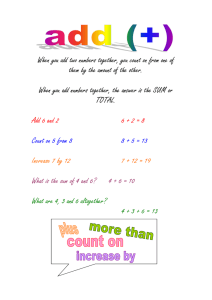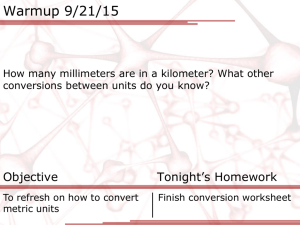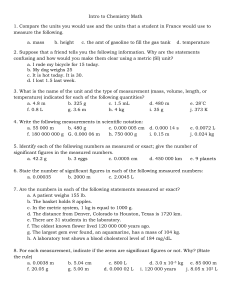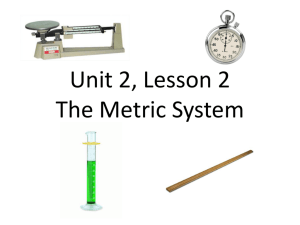The Metric System of Measuring
advertisement
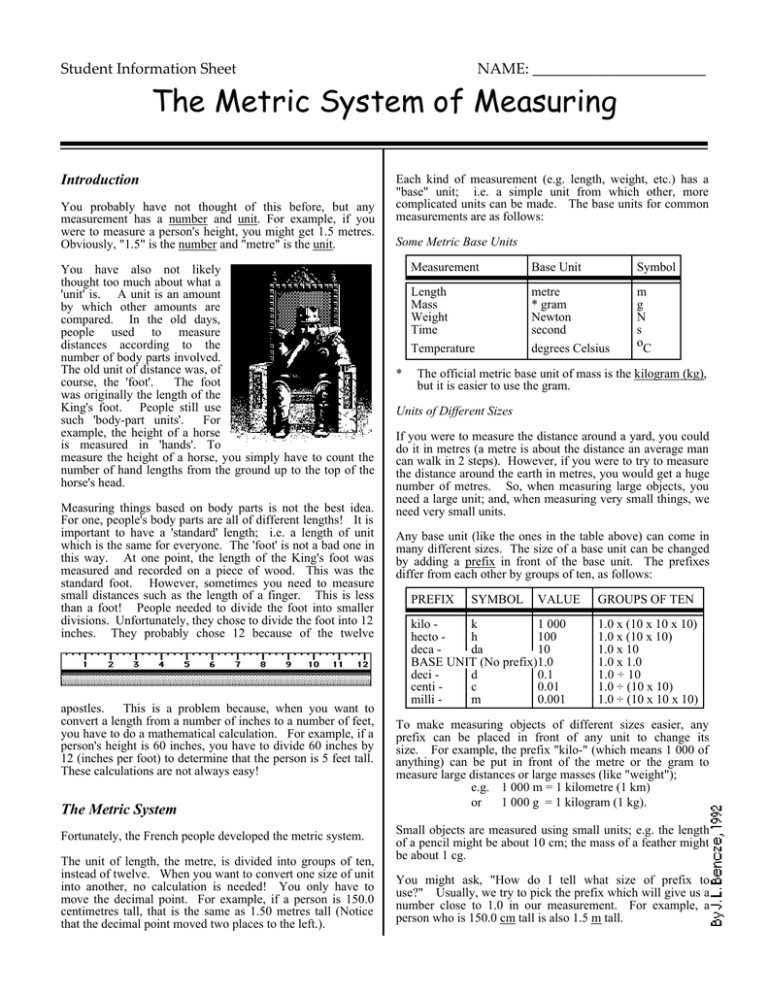
Student Information Sheet
NAME: _______________________
The Metric System of Measuring
Introduction
You probably have not thought of this before, but any
measurement has a number and unit. For example, if you
were to measure a person's height, you might get 1.5 metres.
Obviously, "1.5" is the number and "metre" is the unit.
You have also not likely
thought too much about what a
'unit' is. A unit is an amount
by which other amounts are
compared. In the old days,
people used to measure
distances according to the
number of body parts involved.
The old unit of distance was, of
course, the 'foot'.
The foot
was originally the length of the
King's foot. People still use
such 'body-part units'.
For
example, the height of a horse
is measured in 'hands'. To
measure the height of a horse, you simply have to count the
number of hand lengths from the ground up to the top of the
horse's head.
Measuring things based on body parts is not the best idea.
For one, people's body parts are all of different lengths! It is
important to have a 'standard' length; i.e. a length of unit
which is the same for everyone. The 'foot' is not a bad one in
this way. At one point, the length of the King's foot was
measured and recorded on a piece of wood. This was the
standard foot. However, sometimes you need to measure
small distances such as the length of a finger. This is less
than a foot! People needed to divide the foot into smaller
divisions. Unfortunately, they chose to divide the foot into 12
inches. They probably chose 12 because of the twelve
apostles. This is a problem because, when you want to
convert a length from a number of inches to a number of feet,
you have to do a mathematical calculation. For example, if a
person's height is 60 inches, you have to divide 60 inches by
12 (inches per foot) to determine that the person is 5 feet tall.
These calculations are not always easy!
The Metric System
Fortunately, the French people developed the metric system.
The unit of length, the metre, is divided into groups of ten,
instead of twelve. When you want to convert one size of unit
into another, no calculation is needed! You only have to
move the decimal point. For example, if a person is 150.0
centimetres tall, that is the same as 1.50 metres tall (Notice
that the decimal point moved two places to the left.).
Each kind of measurement (e.g. length, weight, etc.) has a
"base" unit; i.e. a simple unit from which other, more
complicated units can be made. The base units for common
measurements are as follows:
Some Metric Base Units
*
Measurement
Base Unit
Symbol
Length
Mass
Weight
Time
Temperature
metre
* gram
Newton
second
degrees Celsius
m
g
N
s
oC
The official metric base unit of mass is the kilogram (kg),
but it is easier to use the gram.
Units of Different Sizes
If you were to measure the distance around a yard, you could
do it in metres (a metre is about the distance an average man
can walk in 2 steps). However, if you were to try to measure
the distance around the earth in metres, you would get a huge
number of metres. So, when measuring large objects, you
need a large unit; and, when measuring very small things, we
need very small units.
Any base unit (like the ones in the table above) can come in
many different sizes. The size of a base unit can be changed
by adding a prefix in front of the base unit. The prefixes
differ from each other by groups of ten, as follows:
PREFIX
SYMBOL
VALUE
kilo k
1 000
hecto h
100
deca da
10
BASE UNIT (No prefix)1.0
deci d
0.1
centi c
0.01
milli m
0.001
GROUPS OF TEN
1.0 x (10 x 10 x 10)
1.0 x (10 x 10)
1.0 x 10
1.0 x 1.0
1.0 ÷ 10
1.0 ÷ (10 x 10)
1.0 ÷ (10 x 10 x 10)
To make measuring objects of different sizes easier, any
prefix can be placed in front of any unit to change its
size. For example, the prefix "kilo-" (which means 1 000 of
anything) can be put in front of the metre or the gram to
measure large distances or large masses (like "weight");
e.g. 1 000 m = 1 kilometre (1 km)
or
1 000 g = 1 kilogram (1 kg).
Small objects are measured using small units; e.g. the length
of a pencil might be about 10 cm; the mass of a feather might
be about 1 cg.
You might ask, "How do I tell what size of prefix to
use?" Usually, we try to pick the prefix which will give us a
number close to 1.0 in our measurement. For example, a
person who is 150.0 cm tall is also 1.5 m tall.
Student Information Sheet
NAME: _______________________
The Metric System of Measuring
To measure the distance around
the earth, very large units need
to be used, so that the number is
not too large; e.g. The diameter
of the earth at the equator is 12
756 000 metres from on side to
the other! This large number
(12 756 000 m) can be changed
to a smaller number, but with a
larger unit. The unit which is
big enough is the "mega-metre"
(Mm). Therefore, the diameter
of the earth is also 12.756 Mm.
complex units have two or more base units which have either
been divided or multiplied by each other. In the "m/s"
complex unit, the distance in metres have been divided by
the time in seconds.
Metric-Metric Conversions
iii) For liquid volumes (e.g. a carton of milk), any size of the Litre
(L) can be used.
i.e. {1 L = 1000 mL = 1 000 cm3 }
Some other complex units are:
i)
ii) For the 'Volume' of rectangular solids (e.g. a shoe box), any size
of the metre-cubed (m3 ) can be used.
i.e. {m 3 = m x m x m}
Sometimes, we make measurements using a certain size of
unit, but are then asked to "convert" our measurement into a
measurement with a unit of a different size. This is easy in
the metric system because the prefixes differ by groups of
ten. We only have to move the decimal in a number as many
spaces as the difference in the number of spaces between the
two units. The direction of movement of the decimal depends
on whether the new prefix is larger or smaller than the
original prefix. If the new prefix is larger, the new number
must be smaller. You make a number smaller by moving the
decimal to the left.
e.g.
2 500.0 m =
?
km
i) the km is 3 spaces larger than the m
ii) therefore, the number must be smaller powers of ten
iii) therefore, the decimal moves 3 spaces to the left
v)
For the change in temperature per day, use the degree Celsius
per day (o C/day). i.e. {oC/day = o C ÷ day}
REVIEW QUESTIONS: (Answer these on separate paper)
2. Name the unit for each of the following symbols:
a) kg
b) ms
c) dam
d) cg
3. Give the size of each of the following prefixes:
a) kilob) centic) decad) milli-
Therefore, 2 500.0 m = 2.5 km.
Complex Units
4. By how many places (groups of ten) are each of the
following units bigger than the milli-metre?:
a) cm
b) m
c) hm
d) km
You have probably heard of the "kilometres
per hour" unit. For example, the speed limit
in a city is often 50 km/h. Normally, we
don't measure the speed directly. We first
measure the distance and the time, and then
we do a calculation. Dividing distance by
time produces the speed.
5. When you are converting a small unit into a bigger one,
what must happen to the size of the number in a
measurement?
For example, let's say that a runner took 10
seconds to run 100 m (That's fast!).
6. In which direction must you move the decimal place if
you want to make a number smaller?
= Change in Distance
Time
7. Give the new number for each of the following metric
conversions:
a) 10.0 km = ______ m
b) 2 000.0 mg = _____ g
c) 250.0 cs = ______ s
d) 105.0 mN = ______ N
= 100 m
10 s
= 10 m/s
The "m/s" (metre per second) is a "complex" unit.
iv) For the cost of the mass of things (e.g. a piece of steak), use the
dollars per kilogram ($/kg).
i.e. {$/kg = $ ÷ kg }
1. Give the base unit for measuring each of the following:
a) length
b) weight
This is solved, as follows:
Speed
For 'Area' (e.g. the amount of floor space), any size of the
metre-squared (m 2 ) is used. i.e. {m2 = m x m}
These
8. What would be a complex unit for measuring a person's
salary?
